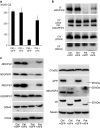NDUFAF4 variants are associated with Leigh syndrome and cause a specific mitochondrial complex I assembly defect
- PMID: 28853723
- PMCID: PMC5643967
- DOI: 10.1038/ejhg.2017.133
NDUFAF4 variants are associated with Leigh syndrome and cause a specific mitochondrial complex I assembly defect
Abstract
Mitochondrial respiratory chain complex I consists of 44 different subunits and can be subgrouped into three functional modules: the Q-, the P- and the N-module. NDUFAF4 (C6ORF66) is an assembly factor of complex I that associates with assembly intermediates of the Q-module. Via exome sequencing, we identified a homozygous missense variant in a complex I-deficient patient with Leigh syndrome. Supercomplex analysis in patient fibroblasts revealed specifically altered stoichiometry. Detailed assembly analysis of complex I, indicative of all of its assembly routes, showed an accumulation of parts of the P- and the N-module but not the Q-module. Lentiviral complementation of patient fibroblasts with wild-type NDUFAF4 rescued complex I deficiency and the assembly defect, confirming the causal role of the variant. Our report on the second family affected by an NDUFAF4 variant further characterizes the phenotypic spectrum and sheds light into the role of NDUFAF4 in mitochondrial complex I biogenesis.
Conflict of interest statement
The authors declare no conflict of interest.
Figures



Similar articles
-
Mutations in mitochondrial complex I assembly factor NDUFAF3 cause Leigh syndrome.Mol Genet Metab. 2017 Mar;120(3):243-246. doi: 10.1016/j.ymgme.2016.12.005. Epub 2016 Dec 11. Mol Genet Metab. 2017. PMID: 27986404
-
NDUFA9 point mutations cause a variable mitochondrial complex I assembly defect.Clin Genet. 2018 Jan;93(1):111-118. doi: 10.1111/cge.13089. Epub 2017 Nov 21. Clin Genet. 2018. PMID: 28671271
-
Impaired complex I assembly in a Leigh syndrome patient with a novel missense mutation in the ND6 gene.Ann Neurol. 2003 Nov;54(5):665-9. doi: 10.1002/ana.10734. Ann Neurol. 2003. PMID: 14595656
-
Mutations in the mitochondrial complex I assembly factor NDUFAF6 cause isolated bilateral striatal necrosis and progressive dystonia in childhood.Mol Genet Metab. 2019 Mar;126(3):250-258. doi: 10.1016/j.ymgme.2019.01.001. Epub 2019 Jan 5. Mol Genet Metab. 2019. PMID: 30642748 Review.
-
Late-onset Leigh syndrome in a patient with mitochondrial complex I NDUFS8 mutations.Neurology. 2004 May 25;62(10):1899-901. doi: 10.1212/01.wnl.0000125251.56131.65. Neurology. 2004. PMID: 15159508 Free PMC article. Review.
Cited by
-
Mitochondrial Respiratory Chain Supercomplexes: From Structure to Function.Int J Mol Sci. 2022 Nov 10;23(22):13880. doi: 10.3390/ijms232213880. Int J Mol Sci. 2022. PMID: 36430359 Free PMC article. Review.
-
An Essential Role for ECSIT in Mitochondrial Complex I Assembly and Mitophagy in Macrophages.Cell Rep. 2018 Mar 6;22(10):2654-2666. doi: 10.1016/j.celrep.2018.02.051. Cell Rep. 2018. PMID: 29514094 Free PMC article.
-
Novel mutations in the mitochondrial complex I assembly gene NDUFAF5 reveal heterogeneous phenotypes.Mol Genet Metab. 2019 Jan;126(1):53-63. doi: 10.1016/j.ymgme.2018.11.001. Epub 2018 Nov 8. Mol Genet Metab. 2019. PMID: 30473481 Free PMC article.
-
Dietary effects on the retina of hamsters.FASEB J. 2025 Mar 31;39(6):e70451. doi: 10.1096/fj.202403390R. FASEB J. 2025. PMID: 40099968 Free PMC article.
-
Using cryo-EM to understand the assembly pathway of respiratory complex I.Acta Crystallogr D Struct Biol. 2024 Mar 1;80(Pt 3):159-173. doi: 10.1107/S205979832400086X. Epub 2024 Feb 19. Acta Crystallogr D Struct Biol. 2024. PMID: 38372588 Free PMC article.
References
-
- Guerrero-Castillo S, Baertling F, Kownatzki D et al: The assembly pathway of mitochondrial respiratory chain complex I. Cell Metab 2017; 25: 128–139. - PubMed
-
- Schwarz JM, Cooper DN, Schuelke M, Seelow D: MutationTaster2: mutation prediction for the deep-sequencing age. Nat Methods 2014; 11: 361–362. - PubMed
-
- Kumar P, Henikoff S, Ng PC: Predicting the effects of coding non-synonymous variants on protein function using the SIFT algorithm. Nat Protoc 2009; 4: 1073–1081. - PubMed
Publication types
MeSH terms
Substances
LinkOut - more resources
Full Text Sources
Other Literature Sources
Molecular Biology Databases

